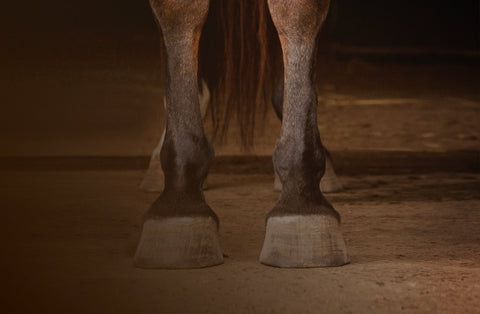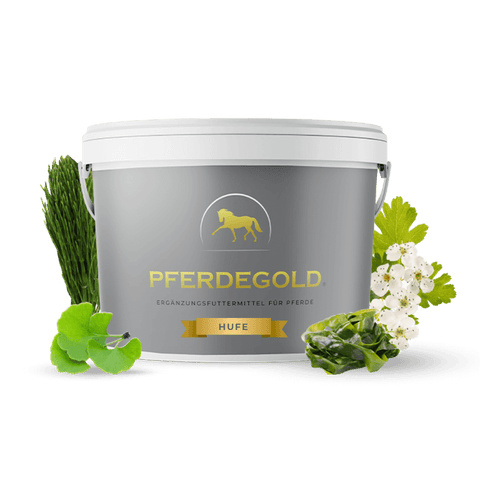
Florian ist aufgewachsen auf einem Bauernhof. Umgeben von Pferden, entdeckte er früh seine Faszination für diese majestätischen Tiere. Inspiriert von seiner reitbegeisterten Mutter, entwickelte er das Nahrungsergänzungmittel - Pferdegold. Seine tiefe Verbundenheit zur Natur und die leidenschaftliche Hingabe zu Pferden trieben ihn an, sein Unternehmen zu gründen.
Thrush in horses: Recognizing, treating & preventing
Thrush in horses is one of the most common and persistent hoof diseases . This bacterial infection affects the sensitive frog and, if left untreated, can lead to severe lameness and permanent damage.
The frog is a complex system of horn and connective tissue that acts as a natural "shock absorber" and plays a central role in the hoof's blood circulation. When this important structure is attacked by putrefactive bacteria, the effects are often more far-reaching than initially apparent .
In this comprehensive guide , you will learn everything you need to know about thrush in horses : from the first warning signs and causes to proven treatment methods and effective prevention strategies .
Veterinary hoof examination - early detection prevents chronic thrush
What is thrush in horses?
Thrush is a bacterial infection of the hoof frog in which anaerobic bacteria (mainly Fusobacterium necrophorum) decompose the frog horn and produce characteristic black, foul-smelling substances.
The function of the frog:
The frog supports blood circulation in the hoof through its pumping function, absorbs shock during walking, and stabilizes the entire hoof mechanism. These functions make it one of the most important structures for hoof health.
Types of thrush
Depending on the severity, a distinction is made between superficial thrush (affects only the outer horny layers), deep thrush (penetrates into the frog cushion) and chronic thrush with permanent tissue changes.
Depending on the severity , the spectrum ranges from slight superficial discoloration to deep frog gaps to complete destruction of the frog horn.
Detecting thrush: correctly interpreting warning signs
The insidious nature of thrush: It often develops unnoticed in moist, poorly ventilated areas of the frog. However, early diagnosis is crucial for successful treatment.
🚨 Immediate warning signs:
- Characteristic rotten, penetrating smell when scraping
- Black, greasy substances between the jet legs
- Pain reaction when pressure is applied to the stream
- Deep cracks or holes in the jet horn
👁️ Recognize gradual development:
-
Dark discoloration at the edge of the frog
-
Softer, crumbly blast horn
- Increased sensitivity during hoof care
- Irregularities in gait on hard ground
💡 Pro tip: The characteristic smell of thrush is unmistakable —once you smell it, you never forget it. Immediate action should be taken at the first sign.

Cleanliness and dryness prevent thrush
How does thrush develop? Understanding the causes
Thrush is caused by a complex interplay of moisture, poor hygiene, and bacterial colonization. Anaerobic bacteria find ideal conditions in low-oxygen, moist environments.
⚡ The main causes:
Thrush is usually caused by persistent moisture such as muddy pastures, poorly mucked stalls or constantly damp runs.
However, care errors are more common: irregular scraping, inadequate hoof care or overlooking the first signs continuously promote bacterial colonization.
Horses with little hoof contact with hard ground, horses kept predominantly in stables, and horses with a narrow frog area or poor hoof shape are particularly at risk.
What to do if your horse has thrush? First aid and treatment
Consistent action is crucial! The earlier treatment begins, the better the chances of recovery.
🛑 Immediate measures:
If thrush is suspected, immediate action is required: First, the hoof must be thoroughly cleaned and all loose, rotten horn removed. Then, the affected area should be disinfected and kept dry. A clean, dry place to stand is essential until the infection has completely healed.
🚨 Call your vet or farrier if: Deep cleft thrush, severe lameness, spread of the infection, or if there is no improvement after one week. There is no self-treatment for severe thrush.
💉 Proven treatment options:
Treatment begins with mechanical cleaning and removal of all affected keratin . Depending on the severity, this is followed by disinfectant rinses, antibiotic ointments, or blast pads . Systemic antibiotics are necessary for deep infections.

Thorough cleansing is the first step in healing
Prevention: How to protect your horse's frog
Prevention is the best protection! With consistent hoof hygiene, most cases of thrush can be prevented.
📈 Intelligent hoof care:
Systematic hoof hygiene:
- Daily thorough scraping of all hooves
- Special attention to the frog furrows
- Regular check for changes
Optimal housing conditions:
- Dry, clean lying areas
- Regular manure removal
- Sufficient exercise on firm ground
🔍 Regular checks:
- Weekly intensive hoof check
- Documentation of abnormalities
- Regular hoof care by a specialist
Preventive nutrition for healthy hooves
A targeted diet can contribute to hoof health in a preventative manner. By providing important nutrients, the quality of the horn is strengthened from within.
🔧 Important nutrients for strong hooves:
- Biotin: Essential for horn formation and quality
- Zinc: Important building block for healthy hoof horn
- Lysine: Important amino acid for strong horn
- Copper: Supports horn pigmentation and structure

Biotin-rich food supplement e.g. from brewer's yeast - Natural support for strong hoof quality
The optimal nutrient combination in Pferdegold Hooves
- Biotin: High dosage for optimal horn formation and quality
- Zinc: Essential mineral for strong, resilient hoof horn
- Lysine: Important amino acid for stable protein structures in the horn
- Copper: Supports healthy horn pigmentation and firmness
⚠️ Important note: Pferdegold Hufe is not related to the disease described in this article. It does not treat any disease and is not a substitute for veterinary diagnosis or treatment. This supplement can only be used as preventative support for healthy horses.

Pferdegold® Hooves
The specially developed supplementary feed Supports natural horn formation and promotes strong, resilient hooves. Made in Germany, grain-free, and with a 30-day money-back guarantee.
Order nowTreatment: The path to complete healing
Consistency is key! Thrush requires systematic and persistent treatment until complete healing occurs.
📅 Typical healing time:
The duration of treatment varies greatly depending on the severity of the infection. Superficial thrush can heal in just 1-2 weeks, while deep infections require 4-8 weeks. Chronic thrush with tissue damage can take several months – patience and consistency are crucial here.
🎯 Treatment steps:
- Daily thorough cleaning and disinfection (weeks 1-2)
- Mechanical removal of affected horn material
- Consistent drying of the affected area (weeks 3-4)
- Rebuilding hoof care and checking horn quality (weeks 5-8)
- Preventive follow-up care to avoid relapses

Strong hooves - Consistent care and the right nutrients support hoof health
Frequently asked questions about thrush
How long does the healing take?
The healing time varies depending on the severity: 1-2 weeks for superficial thrush, up to 8 weeks for deep infections.
Why does thrush return so often?
Thrush usually returns if the causes are not eliminated: persistent moisture, poor hygiene or incomplete treatment.
Can all hooves be affected at the same time?
Yes, especially under poor housing conditions, thrush can affect all four hooves. Systematic treatment of all hooves is then necessary.
Conclusion: Take thrush seriously and prevent it properly
Thrush is one of the most common hoof problems , but it can be largely avoided through consistent prevention . It requires prompt action, systematic treatment, and, above all, permanent changes in housing conditions.
The most important findings:
- Early detection through Daily hoof checks are crucial
- Consistent hoof hygiene and dry housing provide the best protection
- Rapid treatment prevents chronic progression
- Eliminating the cause is more important than treating symptoms
The key lies in prevention: With systematic hoof care, optimal housing conditions and targeted support through quality-promoting nutrition, you can significantly reduce the risk.
Perfect for your horse: Pferdegold® supplementary feed!
These specially developed supplements support your horse's diet and provide it with natural nutrients. Made in Germany, grain-free and drug-free, they come with a 30-day money-back guarantee.
IMPORTANT:
Pferdegold is not a substitute for veterinary diagnosis or treatment. The information contained in this article is for general informational purposes only and is intended to help improve your horse's well-being.
Pferdegold Hufe is not related to the disease described in this article. It does not treat any disease and is not a substitute for veterinary diagnosis or treatment. This supplement can only be used as preventative support for healthy horses.

















